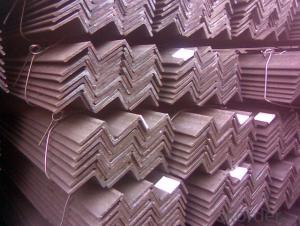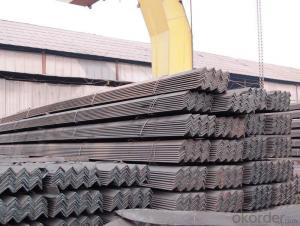Unequal Angle Steel Hot Rolled Steel, GB Standard Unequal Angle Steel
- Loading Port:
- Tianjin
- Payment Terms:
- TT or LC
- Min Order Qty:
- 25 m.t.
- Supply Capability:
- 20000 m.t./month
OKorder Service Pledge
OKorder Financial Service
You Might Also Like
Product Description:
OKorder is offering Unequal Angle Steel Hot Rolled Steel, GB Standard Unequal Angle Steel at great prices with worldwide shipping. Our supplier is a world-class manufacturer of steel, with our products utilized the world over. OKorder annually supplies products to European, North American and Asian markets. We provide quotations within 24 hours of receiving an inquiry and guarantee competitive prices.
Product Applications:
Unequal Angle Steel Hot Rolled Steel, GB Standard Unequal Angle Steel are ideal for structural applications and are widely used in the construction of buildings and bridges, and the manufacturing, petrochemical, and transportation industries.
Product Advantages:
OKorder's Unequal Angle Steel Hot Rolled Steel, GB Standard Unequal Angle Steel are durable, strong, and resist corrosion.
Main Product Features:
· Premium quality
· Prompt delivery & seaworthy packing (30 days after receiving deposit)
· Corrosion resistance
· Can be recycled and reused
· Mill test certification
· Professional Service
· Competitive pricing
Product Specifications:
Grade: Q235, Q235B, Q345, SS400, A36,St37-2
Standard: AISI, ASTM, GB, DIN, JIS
brand:nbsteels
MOQ:20mt
| Size( width*thickness )mm | width*thickness (kg/m) | Size( width*thickness )mm | width*thickness (kg/m) |
| 20*3 | 0.89 | 80*5 | 6.21 |
| 20*4 | 1.15 | 80*6 | 7.38 |
| 25*3 | 1.12 | 80*7 | 8.53 |
| 25*4 | 1.46 | 80*8 | 9.66 |
| 30*3 | 1.37 | 80*10 | 11.87 |
| 30*4 | 1.79 | 90*6 | 8.35 |
| 36*3 | 1.66 | 90*7 | 9.66 |
| 36*4 | 2.16 | 90*8 | 10.95 |
| 36*5 | 2.65 | 90*10 | 13.48 |
| 40*3 | 1.85 | 90*12 | 15.94 |
| 40*4 | 2.42 | 100*6 | 9.37 |
| 40*5 | 2.98 | 100*7 | 10.83 |
| 45*3 | 2.09 | 100*8 | 12.28 |
| 45*4 | 2.74 | 100*10 | 15.12 |
| 45*5 | 3.37 | 100*12 | 17.9 |
| 45*6 | 3.99 | 100*14 | 20.61 |
| 50*3 | 2.33 | 100*16 | 23.26 |
| 50*4 | 3.06 | 110*7 | 11.93 |
| 50*5 | 3.77 | 110*8 | 13.53 |
| 50*6 | 4.46 | 110*10 | 16.69 |
| 56*3 | 2.62 | 110*12 | 19.78 |
| 56*4 | 3.45 | 110*14 | 22.81 |
| 56*5 | 4.25 | 125*8 | 15.5 |
| 56*8 | 6.57 | 125*10 | 19.13 |
| 63*4 | 3.91 | 125*12 | 22.7 |
| 63*5 | 4.82 | 125*14 | 26.19 |
| 63*6 | 5.72 | 140*10 | 21.49 |
| 63*8 | 7.47 | 140*12 | 25.52 |
| 63*10 | 9.15 | 140*14 | 29.49 |
| 70*4 | 4.37 | 140*16 | 33.39 |
| 70*5 | 5.4 | 160*10 | 24.73 |
| 70*6 | 6.41 | 160*12 | 29.39 |
| 70*7 | 7.4 | 160*14 | 33.99 |
| 70*8 | 8.37 | 160*16 | 38.52 |
| 75*5 | 5.82 | 180*12 | 33.16 |
| 75*6 | 6.91 | 180*14 | 38.38 |
| 75*7 | 7.98 | 180*16 | 43.54 |
| 75*8 | 9.03 | 180*18 | 48.63 |
| 75*10 | 11.09 | 200*14 | 42.89 |
| 200*16 | 48.68 | ||
| 200*18 | 54.4 | ||
| 200*20 | 60.06 | ||
| 200*24 | 71.17 |
FAQ:
Q1: Why buy Materials & Equipment from OKorder.com?
A1: All products offered byOKorder.com are carefully selected from China's most reliable manufacturing enterprises. Through its ISO certifications, OKorder.com adheres to the highest standards and a commitment to supply chain safety and customer satisfaction.
Q2: How do we guarantee the quality of our products?
A2: We have established an advanced quality management system which conducts strict quality tests at every step, from raw materials to the final product. At the same time, we provide extensive follow-up service assurances as required.
Q3: How soon can we receive the product after purchase?
A3: Within three days of placing an order, we will begin production. The specific shipping date is dependent upon international and government factors, but is typically 7 to 10 workdays.
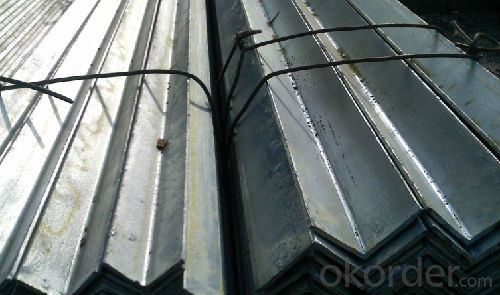
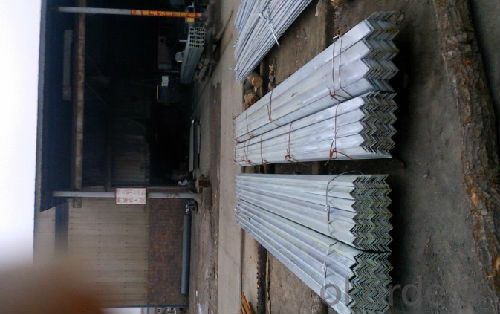
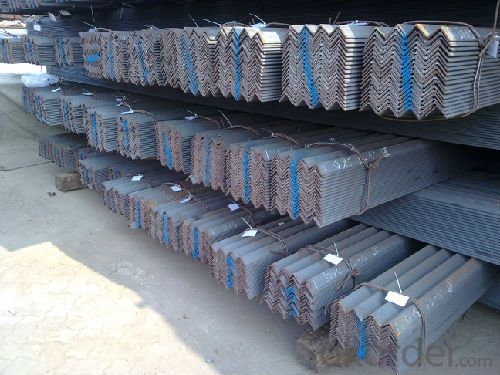
- Q:How do you calculate the compression strength of a steel angle?
- To calculate the compression strength of a steel angle, you need to consider the cross-sectional area of the angle and the yield strength of the steel. The compression strength can be calculated by multiplying the cross-sectional area of the angle by the yield strength of the steel.
- Q:How do steel angles contribute to the overall energy efficiency of a building?
- The overall energy efficiency of a building is enhanced by the use of steel angles in several ways. Firstly, steel angles are commonly employed in constructing building frames and structures, providing the necessary support and stability. By opting for steel angles instead of alternative materials like wood or concrete, the amount of materials needed for construction is reduced, resulting in lower overall energy consumption during the construction phase. Furthermore, steel angles are renowned for their strength and durability, enabling longer spans and fewer support columns. This not only maximizes the usable space within the building but also decreases the requirement for additional heating or cooling systems. By minimizing partitions and obstructions, steel angles facilitate improved airflow and natural lighting, thereby decreasing the energy necessary for artificial lighting and ventilation. Additionally, steel angles can function as a thermal barrier, providing insulation and reducing heat transfer. This aids in maintaining a comfortable indoor temperature throughout the year, cutting down on the reliance on heating and cooling systems and subsequently conserving energy. Moreover, steel angles possess high fire resistance, making them a secure choice for building construction. This diminishes the need for fireproofing materials and systems, resulting in energy savings during both construction and the building's lifespan. Lastly, steel is a highly recyclable material, and steel angles can be recycled at the end of a building's life cycle. By incorporating recycled steel angles into new construction projects, the overall energy consumption and environmental impact can be further decreased. In summary, steel angles contribute to a building's overall energy efficiency by reducing the quantity of materials required during construction, optimizing space utilization, enhancing natural lighting and ventilation, providing thermal insulation, ensuring fire safety, and promoting the use of recyclable materials.
- Q:Can steel angles be galvanized or coated for additional protection?
- Yes, steel angles can indeed be galvanized or coated for additional protection. Galvanizing is a common method used to protect steel from corrosion. It involves coating the steel with a layer of zinc, which acts as a barrier against moisture and other corrosive elements. This process can be done through hot-dip galvanizing, where the steel angle is immersed in a bath of molten zinc, or through electroplating, where a thin layer of zinc is applied to the surface of the steel through an electric current. Coating steel angles with other protective materials is also a viable option. There are various coating options available, such as epoxy, powder coatings, and paint. These coatings create a protective layer on the surface of the steel, shielding it from environmental factors that could lead to corrosion or damage. By galvanizing or coating steel angles, additional protection is provided, extending the lifespan of the material and ensuring its durability in different applications and environments.
- Q:How are steel angles protected against abrasion?
- Steel angles can be protected against abrasion through various methods, such as applying anti-abrasion coatings, using rubber or plastic lining, or incorporating sacrificial wear plates. These protective measures help to minimize the wear and tear caused by friction and ensure the longevity and durability of the steel angles.
- Q:What is the maximum length of a steel angle available in the market?
- The maximum length of a steel angle available in the market can vary depending on the supplier and the specific type of steel angle being referred to. However, in general, steel angles are typically available in lengths ranging from 20 feet (6.1 meters) to 40 feet (12.2 meters). It is important to note that these lengths are commonly found for standard steel angles, but there may be customized options available that could exceed these lengths if required for specific projects or applications. It is advisable to consult with the supplier or manufacturer to determine the maximum length available for a particular steel angle.
- Q:How do steel angles contribute to the sustainability of a project?
- Steel angles contribute to the sustainability of a project in several ways. Firstly, they are made from recycled steel, reducing the demand for new raw materials and promoting a circular economy. Secondly, steel angles have a high strength-to-weight ratio, allowing for lighter and more efficient structural designs, which in turn reduces the amount of steel required and minimizes the carbon footprint of the project. Lastly, steel angles are durable, resistant to corrosion, and have a long lifespan, ensuring the longevity and sustainability of the structure they support.
- Q:Can steel angles be used as reinforcement in concrete slabs?
- Yes, steel angles can be used as reinforcement in concrete slabs. Steel angles provide additional strength and support to the concrete, helping to prevent cracking and increase the load-bearing capacity of the slab. They are commonly used in construction projects where enhanced structural integrity is required.
- Q:What are the different methods of surface preparation for steel angles before painting?
- There are several methods of surface preparation for steel angles before painting. The choice of method depends on the condition of the steel surface and the desired level of paint adhesion and durability. One common method is abrasive blasting, also known as sandblasting. This involves propelling abrasive particles against the steel surface to remove rust, mill scale, and other contaminants. Abrasive blasting not only cleans the surface but also creates a rough profile, which improves the adhesion of the paint. Chemical cleaning is another method used to prepare steel angles for painting. It involves the use of chemical solutions or solvents to remove grease, oil, and other organic contaminants. This method is particularly useful for removing stubborn contaminants that cannot be removed by abrasive blasting alone. Mechanical cleaning methods, such as wire brushing or grinding, can be used to remove loose rust, scale, and old paint. These methods are suitable for smaller areas or localized rust spots. In some cases, power tool cleaning may be sufficient. This involves using power tools such as grinders, sanders, or wire brushes to clean the steel surface. However, it is important to ensure that these tools do not create a polished or smooth surface, as this can reduce paint adhesion. After the surface has been cleaned, it is important to remove any residual contaminants by using a solvent wipe or a clean cloth soaked in a suitable solvent. This step ensures that the surface is free from any remaining contaminants that could affect the paint adhesion. Finally, the steel angles should be primed before painting. A primer provides additional corrosion protection and enhances the adhesion of the topcoat. The choice of primer depends on the specific requirements of the project, such as exposure to harsh weather conditions or chemical exposure. Overall, the different methods of surface preparation for steel angles before painting include abrasive blasting, chemical cleaning, mechanical cleaning, power tool cleaning, solvent wiping, and priming. Selecting the appropriate method ensures that the paint adheres well to the steel surface and provides long-lasting protection against corrosion.
- Q:Can steel angles be used for stairs or handrails?
- Yes, steel angles can be used for stairs or handrails. Steel angles are commonly used in construction as they provide structural support and stability. When used for stairs, steel angles can be incorporated as stringers or supports, ensuring the stability and strength of the staircase. Similarly, for handrails, steel angles can be used as the main frame or support structure, providing a sturdy and safe handrail for users. The use of steel angles in stairs and handrails offers durability, resistance to wear and tear, and the ability to withstand heavy loads, making them a popular choice in construction projects.
- Q:Can steel angles be used for solar panel installations?
- Yes, steel angles can be used for solar panel installations. Steel angles provide structural support and stability for solar panels when they are mounted on rooftops or other structures. They are commonly used to create a framework or mounting system that securely holds the panels in place. Steel angles are strong and durable, able to withstand the weight of the panels and any external forces such as wind or snow loads. Additionally, steel angles can be easily fabricated and customized to fit specific installation requirements, making them a versatile choice for solar panel installations.
1. Manufacturer Overview |
|
|---|---|
| Location | |
| Year Established | |
| Annual Output Value | |
| Main Markets | |
| Company Certifications | |
2. Manufacturer Certificates |
|
|---|---|
| a) Certification Name | |
| Range | |
| Reference | |
| Validity Period | |
3. Manufacturer Capability |
|
|---|---|
| a)Trade Capacity | |
| Nearest Port | |
| Export Percentage | |
| No.of Employees in Trade Department | |
| Language Spoken: | |
| b)Factory Information | |
| Factory Size: | |
| No. of Production Lines | |
| Contract Manufacturing | |
| Product Price Range | |
Send your message to us
Unequal Angle Steel Hot Rolled Steel, GB Standard Unequal Angle Steel
- Loading Port:
- Tianjin
- Payment Terms:
- TT or LC
- Min Order Qty:
- 25 m.t.
- Supply Capability:
- 20000 m.t./month
OKorder Service Pledge
OKorder Financial Service
Similar products
New products
Hot products
Related keywords
